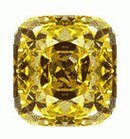| Part of a series on |
| Diamonds |
|---|
 |
| Material |
| The 4 Cs |
| Production |
| Cultural impact |
| Imitations and enhancements |
| Theft |
Diamonds occur naturally and vary in size, color, and quality, so the largest of a particular color may not be large in absolute terms, but may still be considered very desirable. Diamonds may also have high valuations in sale prices, and large ones invariably have a noteworthy ownership history. There is no agreed-upon measure of a large or a high-quality diamond, and new ones displace others on any subjective list, so strict inclusion criteria for notable diamonds are not attainable.







































